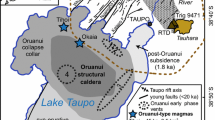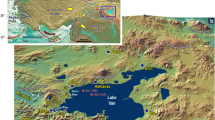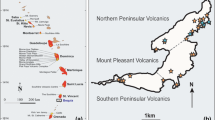Abstract
Glass Mountain, California, consists of >50 km3 of high-silica rhyolite lavas and associated pyroclastic deposits that erupted over a period of >1 my preceding explosive eruption of the Bishop Tuff and formation of the Long Valley caldera at 0.73 Ma. These “minimum-melt” rhyolites yield Fe-Ti-oxide temperatures of 695–718°C and contain sparse phenocrysts of plagioclase+quartz+magnetite+apatite±sanidine, biotite, ilmenite, allanite, and zircon. Incompatible trace elements show similar or larger ranges within the Glass Mountain suite than within the Bishop Tuff, despite a much smaller range of major-element concentrations, largely due to variability among the older lavas (erupted between 2.1 and 1.2 Ma). Ratios of the most incompatible elements have larger ranges in the older lavas than in the younger lavas (1.2–0.79 Ma), and concentrations of incompatible elements span wide ranges at nearly constant Ce/Yb, suggesting that the highest concentrations of these elements are not the result of extensive fractional crystallization alone; rather, they are inherited from parental magmas with a larger proportion of crustal partial melt. Evidence for the nature of this crustal component comes from the presence of scarce, tiny xenocrysts derived from granitic and greenschist-grade metamorphic rocks. The wider range of chemical and isotopic compositions in the older lavas, the larger range in phenocryst modes, the eruption of magmas with different compositions at nearly the same time in different parts of the field, and the smaller volume of individual lavas suggest either that more than one magma body was tapped during eruption of the older lavas or that a single chamber tapped by all lavas was small enough that the composition of its upper reaches easily affected by new additions of crustal melts. We interpret the relative chemical, mineralogical, and isotopic homogeneity of the younger Glass Mountain lavas as reflecting eruptions from a large, integrated magma chamber. The small number of cruptions between 1.4 and 1.2 ma may have allowed time for a large magma body to coalesce, and, as the chamber grew, its upper reaches became less affected by new inputs of crustal melts, so that trace-element trends in magmas erupted after 1.2 Ma are largely controlled by fractional crystallization. The extremely low Sr concentrations of Glass Mountain lavas imply extensive crystallization in chambers at least hundreds of cubic kilometers in volume. The close similarity in Sr, Nd, and Pb isotopic ratios between the younger Glass Mountain lavas and unaltered Bishop Tuff indicates that they tapped the same body of magma, which had become isotopically homogenous by 1.2 Ma but continued to differentiate after that time. From 1.2 to 0.79 Ma, volumetric eruptive rates may have exceeded rates of differentiation, as younger Glass Mountain lavas become slightly less evolved with time. Early-erupted Bishop Tuff is more evolved than the youngest of the Glass Mountain lavas and is characterized by slightly different trace element ratios. This suggests that although magma had been present for 0.5 my, the composiional gradient exhibited by the Bishop Tuff had not been a long-term, steady-state condition in the Long Valley magma chamber, but developed at least in part during the 0.06-my hiatus between extrusion of the last Glass Mountain lava and the climactic eruption.
Similar content being viewed by others
References
Anderson DJ, Lindsley DH (1988) Internally consistent solution models for Fe-Mg-Mn-Ti oxides: Fe-Ti oxides. Am Mineral 73:714–726
Bacon CR, Herschmann MM (1988) Mg/Mn partitioning as a test for equilibrium between coexisting Fe-Ti oxides. Am Mineral 73:57–61
Bailey RA (1984) Chemical evolution and current state of the Long Valley magma chamber. US Geol Surv Open File Rep 84-939: 24–40
Bailey RA (1989) Geologic map of the Long Valley caldera, Mono-Inyo-Craters volcanic chain, and vicinity, eastern California. US Geol Surv Map I-1933
Bailey RA, Dalrymple GB, Lanphere MA (1976) Volcanism, structure, and geochronology of Long Valley caldera, Mono County, California. J Geophys Res 81:725–744
Buddington AF, Lindsley DH (1964) Iron-titanium oxide minerals and synthetic equivalents. J Petrol 5:310–357
Cameron KL (1984) Bishop Tuff revisited: new rare earth element data consistent with crystal fractionation. Science 224:1338–1340
Carle SF (1988) Three-dimensional gravity modeling of the geologic structure of Long Valley caldera. J Geophys Res 93:13237–13250
Carmichael ISE (1967) The Fe-Ti oxides of salic volcanic rocks and their associated ferromagnesian silicates. Contrib Mineral Petrol 14:36–64
Carmichael ISE, Nicholls J, Spera FJ, Wood BJ, Nelson SA (1977) High-temperature properties of silicate liquids: applications to the equilibration and ascent of basic magma. Philos Trans R Soc London Ser A, 286:373–431
Chaudet RE (1986) The petrology and geochemistry of precaldera magmas, Long Valley caldera, eastern California. Unpublished MS thesis, Virginia Polytechnic Institute, 152 pp
Dodge FCW, Calk LC, Kistler RW (1986) Lower crustal xenoliths, Chinese Peak lava flow, central Sierra Nevada. J Petrol 27:1277–1304
Fuhrman ML, Lindsley DH (1988) Ternary-feldspar modeling and thermometry. Am Mineral 73:201–215
Halliday AN, Fallick AE, Hutchinson J, Hildreth W (1984) A Nd, Sr and O isotopic investigation into the causes of chemical and isotopic zonation in the Bishop Tuff, California. Earth Planet Sci Lett 68:379–391
Halliday AN, Mahood GA, Holden P, Metz JM, Dempster TJ, Davidson JP (1989) Evidence for long residence times of rhyolitic magma in the Long Valley magmatic system: the isotopic record in precaldera lavas of Glass Mountain. Earth Planet Sci Lett 94:274–290
Haskin LA, Haskin MA, Frey FA, Wildeman TR (1968) Relative and absolute terrestrial abundances of the rare earths. In: Ahrens LH (ed) Origin and distribution of the elements. Pergamon Press, Oxford, p 889–912
Hildreth EW (1977) The magma chamber of the Bishop Tuff: gradients in temperature, pressure, and composition. Unpublished PhD thesis, University of California, Berkeley, 328 pp
Hildreth W (1979) The Bishop Tuff: evidence for the origin of compositional zonation in silicic magma chambers. Geol Soc Am Spec Pap 180:43–75
Hildreth W (1981) Gradients in silicic magma chambers: implications for lithospheric magmatism. J Geophys Res 86:10153–10192
Hildreth W, Moorbath S (1988) Crustal contributions to are magmatism in the Andes of Central Chile. Contrib Mineral Petrol 98:455–489
Huber NK, Rinehart CD (1967) Cenozoic volcanic rocks of the Devils Postpile quadrangle, eastern Sierra Nevada, California. US Geol Surv Map GQ-437
Izett GA, Obradovich JD, Mchhnert HH (1988) The Bishop Ash Bed (middle Pleistocene) and some older (Pliocene and Pleistocene) chemically and mineralogically similar ash beds in California, Nevada, and Utah. US Geol Surv Bull 1675
James RS, Hamilton DL (1969) Phase relations in the system NaAlSi3O8-KAISi3O8 at 1 kilobar water vapour pressure. Contrib Mineral Petrol 21:111–141
Kistler RW, Peterman ZE (1973) Variations in Sr, Rb, K, Na, and initial 87Sr/86Sr in Mesozoic granitic rocks and intruded wall rocks in central California. Geol Soc Am Bull 84:3489–3512
Krauskopf KB, Bateman PC (1977) Geologic map of the Glass Mountain quadrangle, Mono County, California, and Mineral County, Nevada. US Geol Surv Map GQ-1099
Mahood GA (1981) Chemical evolution of a Pleistocene rhyolitic center: Sierra La Primavera, Jalisco, Mexico. Contrib Mineral Petrol 77:129–149
Mahood GA (1990) A second reply to “Comments by R.S.J. Sparks, H.E. Huppert, and C.J.N. Wilson on “Evidence for long residence times of rhyolitic magma in the Long Valley magmatic system: the isotopic record in the precaldera lavas of Glass Mountain”, Earth Planet Sci Lett (in press)
Mahood GA, Halliday AN (1988) The generation of high-silica rhyolites: a Nd, Sr, and O isotopic study of Sierra La Primavera, Mexican Neovolcanic Belt. Contrib Mineral Petrol 100:183–191
Mankinen EA, Gromme CS, Dalrymple GB, Lanphere MA, Bailey RA (1986) Palcomagnetism and K-Ar ages of volcanic rocks from Long Valley caldera, California. J Geophys Res 91:633–652
Metz JM (1987) Physical and chemical evolution of Glass Mountain: precaldera high-silica rhyolites from the Long Valley magma system. Unpublished PhD thesis, Stanford University, 161 pp
Metz JM, Bailey RA (in press) Geologic map of Glass Mountain, Long Valley, California. US Geol Surv Map I-1995
Metz JM, Mahood GA (1985) Precursors to the Bishop Tuff cruption: Glass Mountain, Long Valley, California. J Geophys Res 90:11121–11126
Michael PJ (1983) Chemical differentiation of the Bishop Tuff and other high-silica magmas through crystallization processes. Geology 11:31–34
Miller CD (1985) Chronology of Holocene eruptions at the Inyo volcanic chain, central eastern California: Implications for possible eruptions in Long Valley. Geology 13:14–17
Nancy MT (1983) Phase equilibria of rock-forming ferromagnesian silicates in granitic systems. Am J Sci 283:993–1033
Ormerod DS, Hawkesworth CJ, Rogers NW, Rogers NW, Leeman WP, Menzies MA (1988) Tectonic and magmatic transitions in the Western Great Basin, USA. Nature 333:349–353
Piwinskii AJ (1973) Experimental studies of granitoids from the central and southern Coast Ranges, California. Tschermaks Mineral Petrog Mitt 20:107–130
Rinchart CD, Ross DC (1957) Geology of the Casa Diablo Mounntain quadrangle, California. US Geol Surv Map GQ-99
Roeder PL (1985) Electron-microprobe analyses of minerals for rare-earth elements: use of calculated peak-overlap corrections. Can Mineral 23:263–271
Sampson DE, Cameron KL (1987) The geochemistry of the Inyo volcanic chain: multiple magma systems in the Long Valley region, eastern California. J Geophys Res 92:104033–10421
Spencer KJ, Lindsley DH (1981) A solution model for coexisting iron-titanium oxides. Am Mineral 66:1189–1201
Stern CR, Wyllie PJ (1981) Phase relationships of I-type granite with H2O to 35 kilobars: the Dinkey Lakes biotite granite from the Sierra Nevada batholith. J Geophys Res 86:10412–10422
Stormer JC (1983) The effects of recalculation on estimates of temperature and oxygen fugacity from analyses of multicomponent iron-titanium oxides. Am Mineral 68:586–594
Stormer JC, Nicholls J (1978) XRFAC: a program for the interactive testing of magmatic differentiation models. Computer Geosci 4:143–159
Sucmnicht GA, Varga RJ (1988) Basement structure and implications for hydrothermal circulation patterns in the west moat of Long Valley caldera, California. J Geophys Res
Travena AS, Nash WP (1981) An electron microprobe study of detrital feldspar. J Sed Pet 51:137–150
Watson EB, Capobianco CJ (1981) Phosphorus and the REE in felsic magmas: an assessment of the role of apatite. Geochim Cosmochim Acta 45:2349–2358
Watson EB, Harrison TM (1983) Zircon saturation revisited: temperature and composition effects in a variety of crustal magma types. Earth Planet Sci Lett 62:295–304
Author information
Authors and Affiliations
Rights and permissions
About this article
Cite this article
Metz, J.M., Mahood, G.A. Development of the Long Valley, California, magma chamber recorded in precaldera rhyolite lavas of Glass Mountain. Contr Mineral Petrol 106, 379–397 (1991). https://doi.org/10.1007/BF00324565
Received:
Accepted:
Issue Date:
DOI: https://doi.org/10.1007/BF00324565




